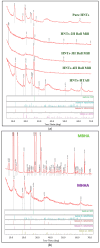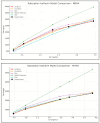Enhanced Vitamin D3 Adsorption Through Novel Hydrophobic Halloysite-Alginate Biopolymer Composites
- PMID: 40284348
- PMCID: PMC12030027
- DOI: 10.3390/polym17081083
Enhanced Vitamin D3 Adsorption Through Novel Hydrophobic Halloysite-Alginate Biopolymer Composites
Abstract
This study presents a sustainable strategy to enhance polymer encapsulation, adsorption, and functional properties by chemically modifying sodium alginate with hydrophobic groups. Hydrophobic alginate derivatives were synthesized via a solvent-free method using hexadecyl trimethylammonium bromide, resulting in nanoparticles capable of effectively capturing non-polar compounds. To further improve compatibility within alginate-based biocomposites, halloysite nanotubes were modified through ball milling and surfactant-assisted treatments. The resulting nanocomposites (MBHA and MHHA) exhibited significantly enhanced adsorption and controlled release behavior, as confirmed by FTIR analysis of hexadecyl alginate ester conjugation. Vitamin D3 adsorption followed the Langmuir isotherm, with high correlation coefficients (R2 = 0.998 for MBHA and R2 = 0.991 for MHHA), indicating monolayer adsorption on a homogenous surface. Kinetic modeling revealed that the adsorption process adhered to a pseudo-second-order model (R2 = 0.9969 for MBHA and R2 = 0.999 for MHHA), suggesting that chemisorption was the dominant rate-controlling mechanism. These results demonstrate the critical role of surface modification in designing nano-engineered biopolymers with superior adsorption, stability, and release profiles, offering sustainable applications in medicine, agriculture, and environmental remediation.
Keywords: alginate-based delivery systems; biopolymer nanocomposites; controlled release; encapsulation efficiency; halloysite nanotubes; polymeric nanocarriers; vitamin D3 adsorption.
Conflict of interest statement
The authors declare no conflicts of interest.
Figures











Similar articles
-
Sodium alginate-encapsulated nano-iron oxide coupled with copper-based MOFs (Cu-BTC@Alg/Fe3O4): Versatile composites for eco-friendly and effective elimination of Rhodamine B dye in wastewater purification.Int J Biol Macromol. 2024 Aug;274(Pt 2):133498. doi: 10.1016/j.ijbiomac.2024.133498. Epub 2024 Jun 27. Int J Biol Macromol. 2024. PMID: 38944086
-
Effect of the supramolecular interactions on the nanostructure of halloysite/biopolymer hybrids: a comprehensive study by SANS, fluorescence correlation spectroscopy and electric birefringence.Phys Chem Chem Phys. 2020 Apr 15;22(15):8193-8202. doi: 10.1039/d0cp01076f. Phys Chem Chem Phys. 2020. PMID: 32249883
-
Preparation and characterization of new low cost adsorbent beads based on activated bentonite encapsulated with calcium alginate for removal of 2,4-dichlorophenol from aqueous medium.Int J Biol Macromol. 2018 Aug;115:257-265. doi: 10.1016/j.ijbiomac.2018.04.064. Epub 2018 Apr 12. Int J Biol Macromol. 2018. PMID: 29655888
-
Probing Antimicrobial Halloysite/Biopolymer Composites with Electron Microscopy: Advantages and Limitations.Polymers (Basel). 2021 Oct 13;13(20):3510. doi: 10.3390/polym13203510. Polymers (Basel). 2021. PMID: 34685269 Free PMC article. Review.
-
Biopolymeric Nanocomposites for CO2 Capture.Polymers (Basel). 2024 Apr 11;16(8):1063. doi: 10.3390/polym16081063. Polymers (Basel). 2024. PMID: 38674984 Free PMC article. Review.
Cited by
-
Effect of acid modification of Biochar derived from spent mushroom substrate on the production of oyster mushroom (Pleurotus ostreatus).Sci Rep. 2025 Aug 22;15(1):30955. doi: 10.1038/s41598-025-16887-5. Sci Rep. 2025. PMID: 40847122 Free PMC article.
References
LinkOut - more resources
Full Text Sources

